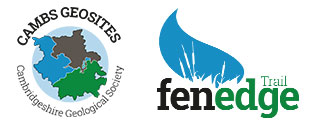

Heydon Chalk Uplands
There are two areas of higher ground in the southern part of the county, the Balsham Chalk Uplands and the Heydon Chalk Uplands, which are separated by the Cam Valley. In both, the rolling landscape is dissected by small streams, with a degraded chalk escarpment facing northwest. There is a fragmented southwest-northeast aligned ridge reaching above 100m OD underlain by Lowestoft Formation Glacial Till that typically forms heavy, poorly drained soils. Patches of Head (slope deposits), Alluvial Fan Deposits and Glacial Gravels are present in a variety of settings. The Zig Zag, Holywell nodular, New Pit and Lewes Nodular Chalk Formations give rise to thin free draining soils.

The Heydon Chalk Uplands landscape is the area of Chalk bedrock to the west of the Cam Valley River Terrace gravels, but not including most of the West Melbury Marly Chalk i.e. it contains the slopes of the Chalk scarp above the Totternhoe Stone outcrop. It is south of the Whaddon Apron and bordered by Essex to the south east and Hertfordshire to the south west. There are no geological SSSI, but two LGS (one chalk spring and one chalk pit) and currently three candidate LGS.
LGS:
Fowlmere Springs – chalk springs arising from the Totternhoe Stone, with influence from the Melbourn Rock
Heydon Chalk Pit – Lewes Nodular Chalk, chalk rafts, Glacial Till


The Geology
The bedrock ranges from a narrow strip of the West Melbury Marly Chalk Fm adjacent to the Totternhoe Stone, to the Lewes Nodular Chalk Fm (with the Chalk Rock at its base) and includes the Zig Zag Chalk, the Holywell Nodular Chalk (with the Melbourn Rock near its base) and the New Pit Chalk Formations. There are small areas of Glacial slope deposits (Head), two patches of Lowestoft Fm Glacial sands/gravels and, high on the ridge, it is covered in part by Lowestoft Fm Glacial till (diamicton). There are minor amounts of River Terrace gravels adjacent to the river valleys. Several patches of Alluvial Fan deposits occur and small amounts of river Alluvium lie along some watercourses.
The Chalk
Chalk is a type of limestone that dates from the Cretaceous period having been formed between about 90 and 99 million years ago, mostly from the carbonate remains of marine algae and various animals that sank to the bottom of a relatively warm, deep sea. These chalk hills extend south and north, linking our local ‘uplands’ with the Chilterns, the North and South Downs and, in the north, the Yorkshire Wolds.
Within the Chalk there are numerous layers (called formations), each with its own characteristics and most made up of several beds of different material. Some beds within the chalk are relatively hard and the rock has been used for building stone, whilst others, called marls, are soft as they contain higher levels of clay minerals. The type and quantity of fossils in each layer is also distinctive and enables geologists to trace the formations across, not only the country, but also the London-Paris basin and even further afield.
Two of the harder bands of chalk that can be seen in Cambridgeshire are named after local places. The most famous is the Totternhoe Stone, named after Totternhoe in Bedfordshire, which was formed about 95-96 million years ago and has been used for many local buildings including some of the colleges in Cambridge. It was quarried at a number of locations in the south of the county including Cherry Hinton and Burwell, hence its other name of Burwell Rock, The second is the Melbourn Rock, named after the village of Melbourn in Cambridgeshire, which is a little younger at roughly 93-94 million years old. Due to the fact that water can easily flow through fissures in these hard bands and that they lie above layers of far less permeable chalk marls, they are each associated with a spring line that feeds ecologically important chalk streams that flow into the Cam Valley.
In the past, many fossils were found in the chalk quarries of Cambridgeshire and several of these can now be seen at the Sedgwick Museum of Earth Science in Cambridge. There are no longer good sites for collecting, however, as most of the quarries are now disused and infilled and most fossils have been removed.
For more info on the geology of the Chalk hills, see Hertfordshire Geological Society.
Earth Heritage stories/known or potential geological features
Holocene sediments and environments – alluvium, peat
Pleistocene ‘Ice Age’ sediments/environments – till, gravels, alluvial fans
Pleistocene geomorphology, glaciations, chalk rafts, tunnel valleys, brecciated chalk
Pleistocene fossils
Cretaceous (Chalk) deposition/tectonic setting/environments (each strata)
Chalk escarpment – structural geology, tectonic history, geomorphology
Cretaceous fossils
Hardgrounds – Totternhoe Stone, Melbourn Rock, Chalk Rock
Chalk Springs and streams, aquifers, water table
Building Stone sources, archaeological stone use – flints
Quarrying, water management (watercress industry)


Steeple Morden Quarry, containing deposits of White Chalk including the Melbourn Rock near its base.

Fowlmere Springs LGS (chalk springs)

Flint bands in the White Chalk at Steeple Morden Quarry.




